The exhaust position is important for packaging and aerodynamic reasons. There are mainly two options for positioning the exhaust, the one is laterally, beside the engine end just after the rider and the other is at the back of the bike, in the tail. Of course there are numerous variations and also combinations.
In the first version of the desmosedici race bike (2003-2004) the exhaust was in the tail of the bike, as shown in the image below:
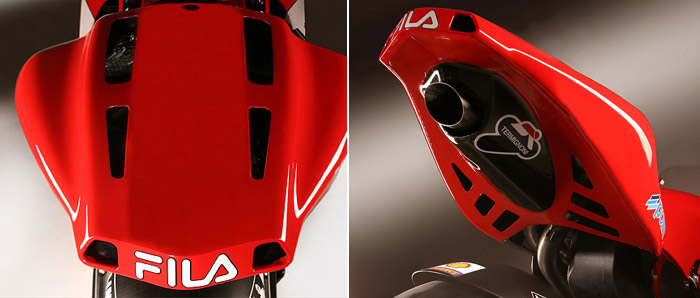
In the following 2005-6 version and under the influence of the new, relaxed in matters of noise, regulations the exhaust pipes were much simpler and the gas momentum was greater. The exhaust exits are now four, two in the back (in the same place with the previous version's exhaust) and two laterally beside the engine.
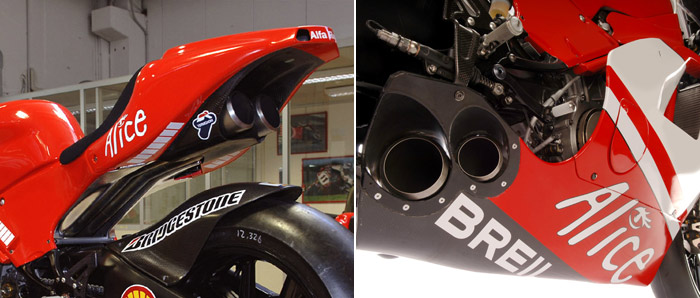
The exhaust gases momentum from the two exits in the back (about half of the total flow) should be approximately the same as the one in the single exhaust of the previous version which although it received the total gas flow it has to reduce its momentum for noise regulations. The result is that the two versions should have similar aerodynamic behavior considering the influence of the exhaust gases.
The exhaust in the RR is placed at a very unusual position. Although the exhaust in the rear on the bike is now almost mainstream, here we have the exhaust facing upwards. It should be noted that even the track only exhaust of the RR is subjected to noise regulations much more strict than the race bike's.
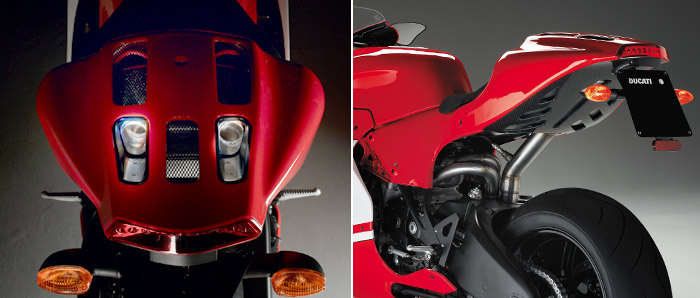
The exhaust is a substantial source of momentum for the airflow. A 1000cc engine rotating at 16.000 rpm produces approximately 8.000 liters of gas every minute. In the final section of this article we will analyze qualitatively the aerodynamic influence of the exhaust placement. It is important here to notice that the aerodynamic of a body is defined, apart from its geometry, from sources of fluid mass/momentum and attached vortices (not examined in this article).
In the image below you can see the motorcycle/rider and also the equivalent aerodynamic body (shown with a lighter shade and indicated by the pink arrow marked 'EAB'). This represents the complete effect that the total body of the motorcycle/rider and the source of mass/momentum (the exhaust) have in the airflow. The center of gravity (circle with black and white), the center of aerodynamic pressure (white circle) and their respective distance (green line) is also pictured. The red arrow shows the direction of the gases exiting the exhaust.
The following images are for examining the subject qualitatively, they are not based in actual experiments or simulations and the shapes and sizes appearing on them are not necessarily real.
A very important factor for the stability of the motorcycle (or vehicle in general) is the distance between the center of gravity and the center of pressure. The more the center of pressure is aft of the center of gravity, the greater the recovering torque that restabilizes the bike under any perturbation.
In this first image the exhaust is positioned laterally, as in many commercial superbikes, especially in the past.
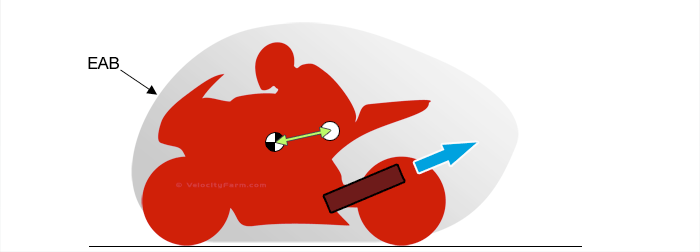
The flow in this case is not affected from the exhaust because the gas momentum is released outside the wake. In the rear of the bike there is a lot of turbulence because the geometry is very steep and the flow cannot follow it.
In the following image the exhaust is positioned at the back of the bike facing backwards, as used by many sport bikes. Here the momentum from the exhaust gases is released at the area where there was a separation problem. Thus the flow is not disturbed and the separation occurs at a greater distance aft of the bike. The equivalent aerodynamic body now is more streamlined, producing smaller amounts of drag and also the center of pressure moves backwards increasing the stability of the bike. The effect of this exhaust position simulates and behaves similar to a longer and more streamlined body.
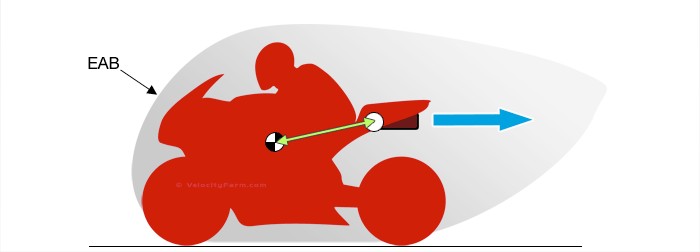
The Desmosedici RR uses a variation of the case described. It also places the exhaust at the back of the bike but the exit is facing also upwards thus changing the profile of the equivalent aerodynamic body.
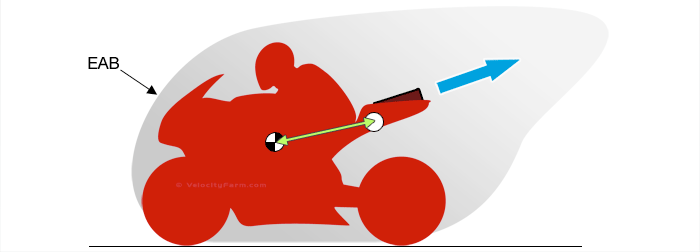
In this case we have a profile that largely simulates that of an inverted airfoil and it should improve stability and traction by decreasing the aerodynamic lift.
It is obvious in the last two cases that the aerodynamic behavior is closely related to the operation of the engine. With full throttle and at high rpm the stability of the motorcycle is augmented because of the large momentum produced by the exhaust gases. Even though this at first seems that the behavior of the bike could be unpredicted in reality the throttle/rpm interaction shouldn't be a concerning factor. In high speeds where the stability is most wanted the engine is operating at high revs and with full throttle in order to overcome the drag. Also in sudden acceleration the aerodynamic stability enhancement from the exhaust is produced accordingly and on the contrary, when braking modern sportsbikes use almost exclusively the front tire so any aerodynamic assist wouldn't be really important.
In conclusion we can say that even though dependant from the engine operation, exhaust gases could provide a useful assist over the aerodynamic stability of the bike.

Epilogue.The Desmosedici RR even though it isn't a ground breaking motorbike, it consist the showcase of Ducati technology level and race expertise. Many of its features will filter down the rest of Ducati range and possibly other motoGP teams will produce race replicas in the future.